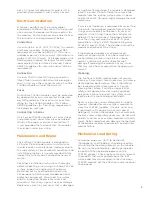
0
2190700001
Factory Code
YY MM
Mechanical Installation
Approved Roof Systems
The FLEX60 module is certified by CSA as part
of a Class A roofing system per UL 790 when
installed over TPO, EPDM, and PVC roofing
systems when the following requirements are
met:
• The FLEX60 module with Heliobond and the
Sunflare raceway wire management system
is certified as Class A over any Class A TPO
roofing constructions. The maximum slope is
1/4:12 unless the certified construction has a
non-combustible barrier board directly under
the roofing membrane. In that case, the max
slope is equal to that of the certified roofing
construction.
• The FLEX60 module with Heliobond and the
Sunflare raceway wire management system
maintains Class A fire ratings when installed
in combination with any Class A EPDM or
any Class A PVC roofing construction that
includes a non-combustible barrier board
directly under the membrane as specified in
the roofing manufacturer’s listing. The max
slope is equal to that of the certified roofing
construction.
The following table outlines the allowable
installation configurations:
Roofing
Covering
Material
Roofing
System Class
Requirement
Sunflare Approved
Adhesive
Cover
Board
Required
Sunflare
Wire Tray
Required
Max
Slope
TPO
Class A
Class A
Class A
Class A
HelioBond PVA 600BT
HelioBond PVA 600BT
HelioBond PVA 600BT
HelioBond PVA 600BT
No
1/4:12
Yes
Yse
Yes
Yes
TPO
Yes
Per Listing
Per Listing
Per Listing
EPDM
Yes
PVC
Yes
Notes: (1) Max slope “Per Listing” means per the
roofing systems listing prior to the addition of the
FLEX60 module. (2) The cover board must be directly
under the roofing membrane.
Roofing Membrane Manufacture Approvals
The Flex60 module is fully engineered to reduce
stresses on roofing membranes and provide a
compatible interface. Never-the-less, before
installing Flex60 with Heliobond PVA 600BT
per these instructions, you must obtain approval
from the roof membrane manufacturer. Ensure
you follow all their recommendations and
requirements. Sunflare makes no guarantees nor
warranties in relation to the roofing membrane
and therefore takes no liability for damage or
leaks in the membrane that might be caused from
installing the modules.
Roof Membrane Prep
The roof surface must be thoroughly cleaned
prior to installation and primed if required to
meet load requirements. The surface needs to be
free from dust and dirt prior to module adhesion.
Failure to properly clean the roofing membrane
can result in much lower load capacities than
calculated and could result in module adhesive
failures resulting in an electrical arc and flying
debris hazards that could lead to fires and
personal injury.
Besides dust and debris, the roof surface must
be dry and free from water, ice or snow prior
to module installation. In addition, the roofing
surface must be between 40°F -120°F (4°C
to 49°C) during installation. Failure to follow
these requirements will result in poor adhesion
that could lead to premature failure resulting in
electrical arcs and fires, and flying debris and
personal injury. In addition, poor adhesion due
to insufficient roof prep can result in moisture
conditions under the modules that facilitates
unwanted microbial buildup. This could lead
to mold and rot of the laminate and the roof
membrane. Sunflare will not take liability
for degradation or failure of the module or
the roofing membrane resulting from poor
installation.
To meet the required load capacity, it might
be necessary to prime the roofing surface. Use
only primers specified by the roof membrane
manufacturer and follow all manufacturers
instructions for application. Immediately install
the FLEX60 module upon completion of the
priming of the surface.
Module Installation
After the roof has been cleaned to the
requirements above, the module can be stuck
down to the roof. Use chalk lines or other
methods to ensure a straight edge for placing
the modules. Place the modules so their j-boxes
are facing the modules of the next row as shown
in Figure 1 to form a row pair. Ensure there is
a 1.625” ± 0.25” (1-5/8” ± 1/4”) gap between
adjacent module rows. Within a row, the modules
should be installed right next to each other with a
0” gap between them. This is to ensure that water
does not pond between modules. When sticking
the modules down to the roof, first remove the
release sheets from the adhesive on the back of
the module. Align the j-box short edge of the
modules to the chalk line and roll the module
down onto the roof. The adhesive is pressure
activated. Apply a pressure of 15 psi across all
6

































